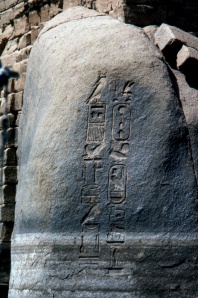We’d reached the town of Wadi Halfa in the northern Sudan when a humid wind hit the overland truck. While traveling through the desert avoiding the impassable banks of the Nile, we were astonished when the breeze suddenly felt moist.
I understood that Lake Nasser must be close. This body of water, created by the Aswan High Dam, has forever changed the climate of the region. Rain now falls occasionally along its length, a feat of nature seldom seen before the dam was constructed. Yet the dam has proved to be a mixed blessing. The Nile no longer floods in Egypt, resulting in a build-up of silt that used to be flushed into the Mediterranean Sea along with the polluted run-off from the millions of people who live beside the great river.
But these concerns were far from our minds at the time. We spent several days in Wadi Halfa awaiting the next sailing of a vessel down the lake and over the border from the Sudan to Egypt. These boats, ancient paddle-wheelers that dated from the time of British rule, plied the lake on an intermittent schedule between the two countries.
1) Paddle-wheeler on the lake: Photo by Steve Routhier
A cruise of Lake Nasser sounded like a fine adventure. The big day arrived after many rumors of departure proved to be premature. I can’t recall the reason, but we decided to walk from Wadi Halfa town to the boat dock, a distance of several kilometers through the desert. It was a hot sojourn, trudging through the endless sand with all our gear.
Somewhere in the remote region of the northern Sudan my friend Jack and I had stumbled upon a Frenchman who’d spent years in Africa. He sported a brilliant white turban and with his beard he looked like an Arab himself. Upon hearing that I was Canadian, he immediately cried, “Lennoxville!” Other than the big Canadian cities it was the only town he knew of in Canada. Naturally I was endeared to him for his psychic abilities in determining my own hometown.
So the three of us humped together in the great and unremitting heat to the Lake. The steamer was there awaiting its passengers, most of whom had sensibly arrived from Halfa by truck. We tore off our outer clothes and dove into the Lake. Memorably, a small crocodile swam past when I was a hundred meters from shore, putting an abrupt end to our water frolicking.
Our attention turned to the boat. Since the original vessel was not capacious enough for the number of people who traveled back and forth between the two countries, metal barges were lashed to it on both port and starboard sides. We quickly understood that, with our cheap tickets, one of the barges would serve as our “seat” for the trip. We also noted that a position near the bow would be the most desirable, as the breeze from the boat’s motion would be the only relief from the heat. The metal barges, we figured, sucked up the sun like sponges and would radiate the heat onto the hapless folks who were stuck outside without shade.
And so we found a spot and stretched out some blankets to claim it, surrounded by effusive Egyptians and Sudanese. Meals of beans and pita bread, served twice a day, took care of our dietary needs for the duration and the bango we brought with us filled our entertainment quotient. It never occurred to us that by smoking it in the forward part of the boat the scent would fill the rest of the barge, but then many of the other passengers were puffing away themselves.
The scenery during the journey was stark, moon-like, and vast. Deep valleys filled with water, mountain tops rose over the watery horizon and the shoreline loomed in the distance like an unreachable promised land. At night the stars shone with relentless intensity and by day the sun bore down, steering us into a state of climatic transcendence.
2) Lake Nasser: photo by Steve Routhier
Departing the paddle-wheeler at the end of the three-day trip, just upstream from the High Dam, a scattering of other Western travelers regarded us with something between suspicion and amazement. Unlike them, we had not been aboard the train from Abu Hamed to Wadi Halfa. They must have wondered how we had arrived at the boat in the first place.
A train at the dock ran along the Nile into Aswan town, an oasis after our weeks in the Sahara.
3) Kitchener’s Botanical Garden on Bustan Island, Aswan: a welcome relief from the desert
We saw the many sights of the town including the famous and ancient “Nilometer”, once used by Egyptians to measure changes in the river’s level.
4) The Asawn Nilometer: photo by Ken and Peg Herring
It was no longer of any use, even if locals could have read the hieroglyphics. The Nile had been tamed by humans, just as they had also tamed this part of the Sahara and brought water to an arid world. The ultimate impact on African and world ecology was anybody’s guess.
And so the world moved on in ways we could only guess at, as we ourselves moved forward from the deserts to the cities, from realms of magic to those of the mundane.





I can’t believe I didn’t hop to North Sudan while in Aswan. Even though I lived in Egypt for one full year, Lake Nasser somehow escaped me. I can’t wait to get back to Egypt and take that journey!
– Maria Alexandra